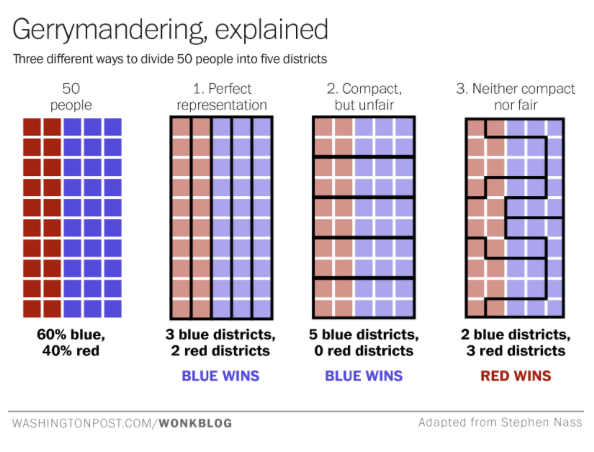This article is written in conjunction with the IEU Law Society.
By: Reed FliegelGerrymandering is a very useful tool for politicians of any intention, good or bad. Simply put, it is the process of manipulating or “custom drawing” electoral maps to favor a class or group. This Washington Post diagram showcases how it works quite well:

Gerrymandering can serve as a tool of both well and evil meaning politicians, but how does that work? Party affiliations and groups are never as conveniently organized as the chart examples, and in these instances, gerrymandering can be used to achieve Graph 1’s “perfect representation.” Say that a region has a 20% Latino population, by drawing a somewhat unique-looking district one could clump these voters together, and allow them to send a candidate that suits them to Washington. Otherwise, this 20% of the population would be diluted into each district, and Latinos, who constitute a fifth of the area’s population, would go largely unrepresented. This is the difference between graph #1 and graph #2 on the diagram.
Gerrymandering in action
A great example of this is North Carolina’s District 12 and District 1, both drawn to create majority-black voting districts in North Carolina. Districts 1 and 12, before the 2016 reform, are pictured to the right. The debate over these two districts was, and remains, very heated. Some argue that this effectively creates two districts (which is largely proportional to the black population of the state) in which black people are the majority and can choose the leaders that they prefer. Others argue that this clusters the votes of people of color within designated borders drawn solely on race, which dilutes their sway in the surrounding areas.

Shockingly (or maybe not so shockingly), democrats and republicans in the state have largely flip-flopped perspectives on this matter depending on who was in office. The large question of the entire matter remains: to what extent is it lawful and acceptable to draw districts based solely on race to ensure minority representation? In my opinion, districts like the 12th give needed and deserved representation to the diluted African American community; a representation that would not be seen otherwise in a nearly 70% white state, but many do not see it this way.
Legal developments in Arkansas
The controversial nature of gerrymandering has led to many lawsuits, all of which, from one perspective or another, focus on voting rights. In the South, there is a long history of politicians minimizing black votes with craftily drawn district lines and an equally long history of blacks fighting against this in court.
Just this year, the Supreme Court ruled in favor of black voters who had sued Alabama for violating Section 2 of the Voting Rights Act. The court ruled in their favor and required the state to create a new map with an additional majority-black voting district. This exemplifies how the ability for individuals to sue based on the Voting Rights Act has allowed black voters to maintain the representation they deserve in states like Alabama.
However, in a landslide ruling, this right to sue has been rolled back severely. The state of Arkansas was sued in an attempt to appeal a new congressional map passed by the Republican-dominated state legislature. In response, the 8th Circuit Court of Appeals ruled 2-1, despite the long history of practice, that only the Attorney General can pursue cases relating to the Voting Rights Act, and individuals now cannot.
This is a clear overturning of precedent, and it severely weakens the power of southern minorities to protect their right to vote, like they did earlier this year in Alabama. There is a very high chance that this will reach the Supreme Court, and should it be upheld, the capabilities of ordinary citizens to defend their often denied right to vote will be severely limited.







